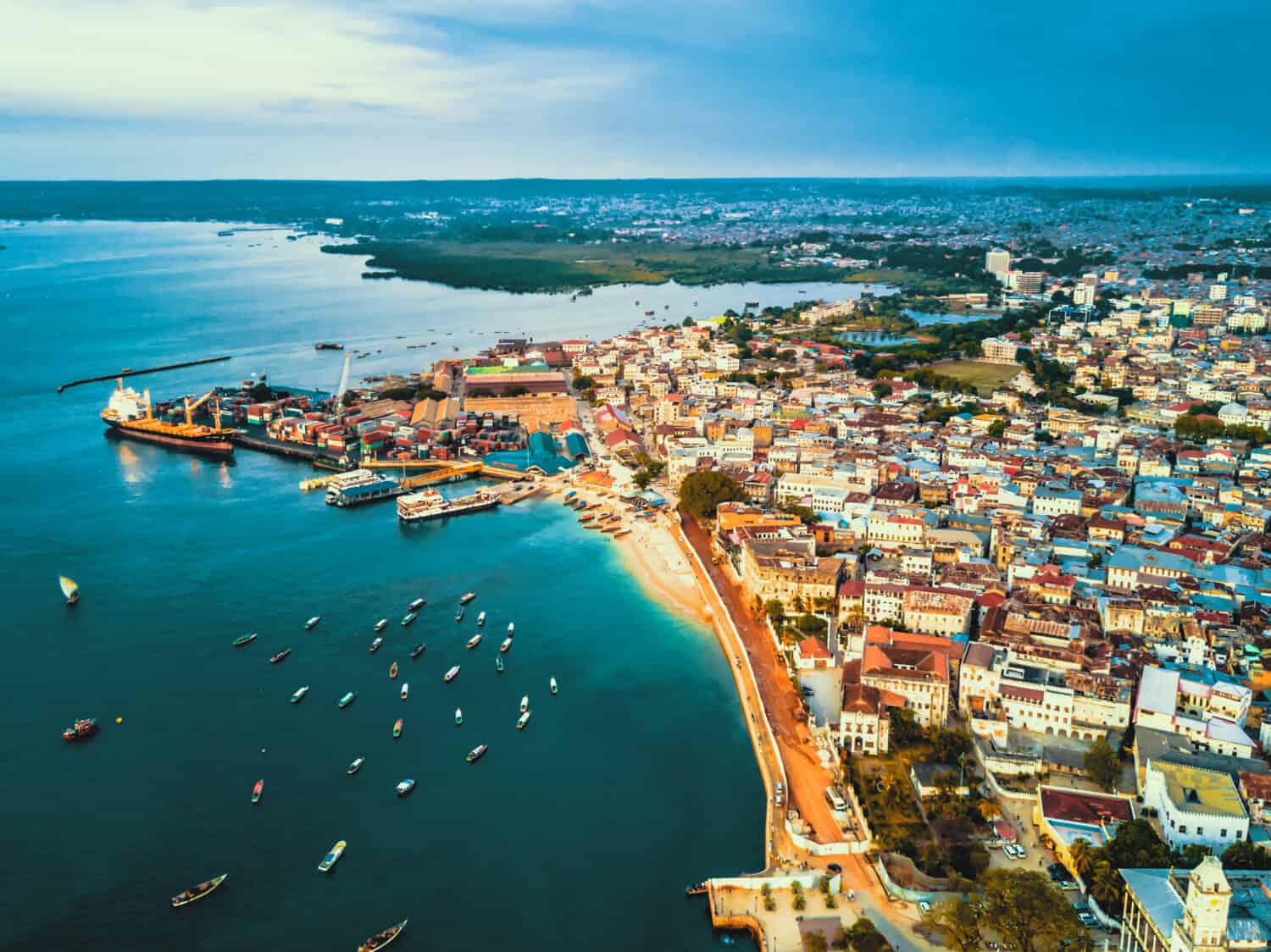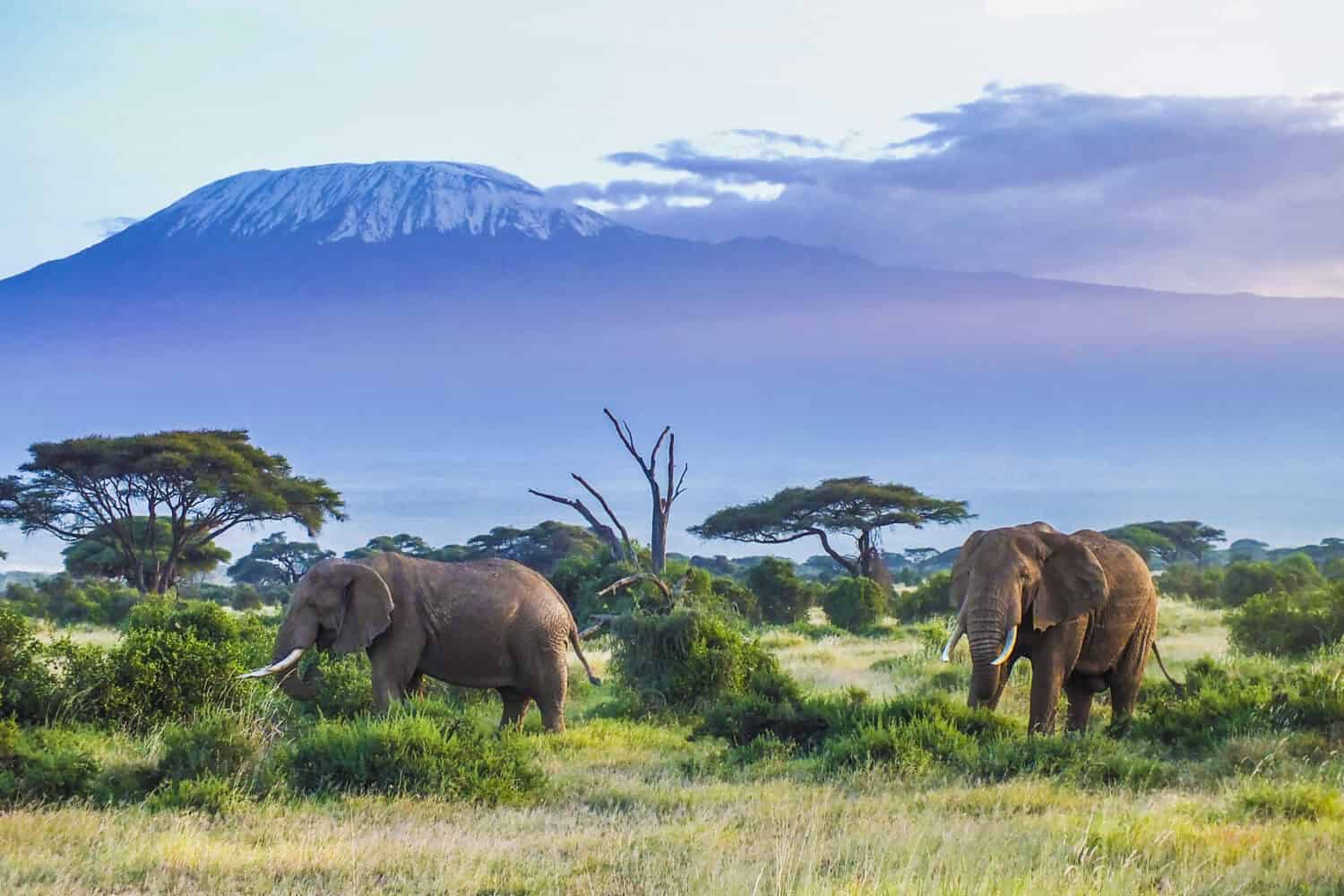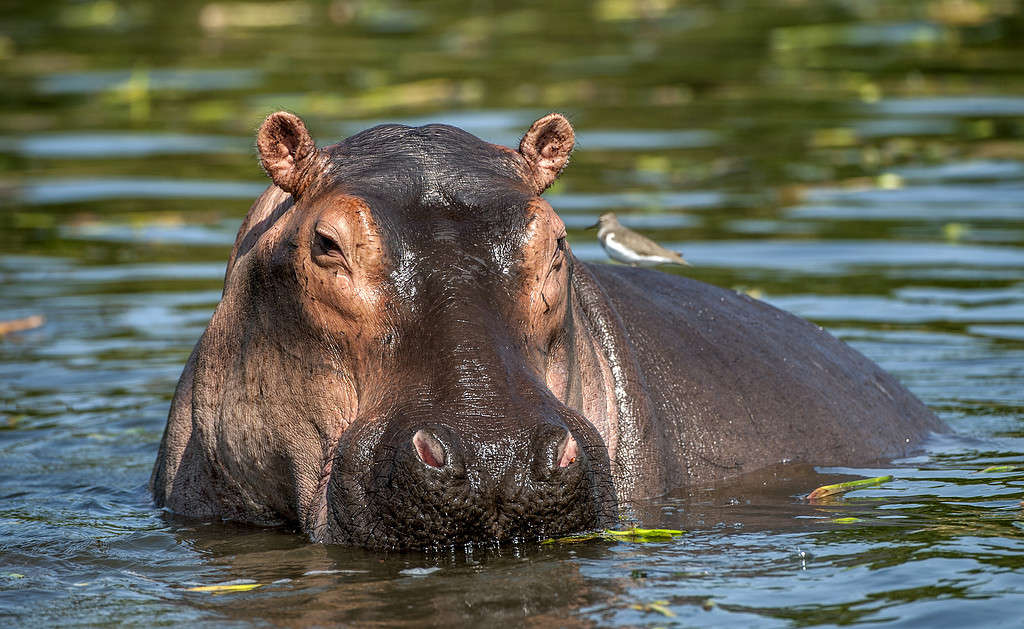Lake Victoria is a stunning lake nestled in the heart of the African Great Lakes Region in East Africa. Bordered by Kenya, Tanzania, and Uganda, Lake Victoria covers 26,600 square miles (68,800 square kilometers). With its extensive size, Lake Victoria is the largest freshwater lake in Africa and the second-largest in the world, behind Lake Superior across Canada and the USA.
Lake Victoria is home to a diverse range of ecosystems and extensive wildlife. The lake supports a thriving fishing industry and provides a key transportation route for trade and travel within the region. It offers vital resources and plays a crucial role in the ecology, economy, and culture of the nations bordering it. Lake Victoria also plays a significant role in the livelihoods of millions of people.
Where Is Lake Victoria Located on a Map?
Lake Victoria is located in the eastern part of the African continent, in the African Great Lakes Region. The lake straddles the equator. Lake Victoria’s northern shores are almost entirely in Uganda, and the southern shores border Tanzania. Kenya has a smaller border with the lake on its eastern shores.
The lake has a unique geographical location within the East African Rift system. This is a tectonic boundary where the African tectonic plate slowly splits apart. As a result, Lake Victoria is part of a series of interconnected lakes, including Lake Tanganyika and Lake Malawi. All are nestled within the Great Rift Valley. These interlinked lakes contribute to the geological and ecological diversity of Lake Victoria’s surrounding region.
Between Kenya, Tanzania, and Uganda, Lake Victoria’s surroundings range from fertile plains and rolling hills to wetlands and lush forests.
Tanzania

Zanzibar is a city located in the Zanzibar archipelago, east of Tanzania. It is one of the country’s hidden gem.
©Nick Johanson/Shutterstock.com
In East Africa, Tanzania shares its northern border with the southern shores of Lake Victoria. The country comprises 49% of Lake Victoria, which equals 13,000 square miles (33,700 square kilometers).
The lake plays a vital role in Tanzania’s socio-economic landscape. It provides crucial water resources, supports fishing communities, and contributes to the nation’s agricultural and industrial sectors. The lake also impacts the culture and daily life of those living nearby.
But Lake Victoria is only a small feature of Tanzania. This large country covers approximately 365,756 square miles (947,303 square kilometers) and is Africa’s 13th largest country. With its large size, Tanzania borders eight countries. To the north, it shares borders with Kenya and Uganda. To the west, it is bordered by Burundi, the Democratic Republic of Congo, and Rwanda. Tanzania shares its southern border with Malawi, Mozambique and Zambia. Finally, to the east, the country borders the Indian Ocean.
In 2022, Tanzania had a population of over 61 million, with many ethnic groups and communities coexisting. The Swahili language is the most spoken in Tanzania, but the country is also home to 125 other languages. Tanzania was a center of trade for centuries. The Germans and British later colonized it before gaining its independence in 1961. Tanzania’s first president, Julius Nyerere, shaped the nation’s post-colonial identity with his philosophy of Ujamaa, which emphasizes self-reliance and communal living.
Tanzanian culture is heavily influenced by indigenous and religious beliefs, specifically Christianity and Islam. The population celebrates a wide array of festivals and rituals throughout the year. Traditional music and dance, such as the lively Bongo Flava and Taarab styles, are integral to Tanzanian life.
Things to See in Tanzania

Tanzania is home to stunning national parks and is one of the best destinations for safaris.
©HordynskiPhotography/Shutterstock.com
Tanzania is a haven for safaris and boasts some of the world’s most beautiful and wildlife-filled national parks. Here are some of its most famous.
Mount Kilimanjaro National Park
Mount Kilimanjaro is Africa’s highest peak at Tanzania’s northern border with Kenya. This stunning snow-capped mountain is 19,341 feet (5,895 meters) above sea level. Every year, it attracts thousands of tourists, some of whom try its harsh ascent.
Serengeti National Park
This park is considered the crown jewel of Tanzania’s national park system. This vast expanse of grasslands, woodlands, and savannahs is home to the Big Five (buffalo, elephant, leopard, lion, and rhinoceros). The Great Migration happens yearly in Serengeti, where millions of wildebeest, zebras, and other herbivores move in search of fresh grazing.
Ngorongoro Conservation Area
This UNESCO World Heritage Site is home to the Ngorongoro Crater, a massive volcanic caldera teeming with wildlife. The crater floor is a self-contained ecosystem. It provides an exceptional habitat for various animals, including lions, cheetahs, and the endangered black rhinoceros.
Ruaha National Park
Ruaha is a wilderness haven with various landscapes and is renowned for its high concentration of predators, including cheetahs, leopards, and lions.
Tarangire National Park
Tarangire National Park is a hidden gem in Tanzania. The park is famous for its large populations of elephants, tree-climbing lions, and diverse birdlife. Plus, it is home to stunning baobab trees.
Lake Manyara National Park
Nestled between the Great Rift Valley escarpment and Lake Manyara, this park is famous for its tree-climbing lions and extensive birdlife. It offers diverse ecosystems, from dense forests to open savannahs.
Nyerere National Park
Nyerere National Park, also a UNESCO World Heritage Site, is home to an array of wildlife, including elephants, hippos, crocodiles, and various bird species.
Katavi National Park
This national park is more remote and less visited. However, it offers vast floodplains, lush marshes, and abundant wildlife, including large herds of buffalo, elephants, and hippos. This is the perfect place to avoid the potential crowds of other national parks.
Mahale Mountains National Park
Finally, this park, on the shores of Lake Tanganyika, is the perfect place to observe various chimpanzee populations in their natural habitat.
Uganda

Kampala is Uganda’s capital city.
©Aleksandr Stezhkin/Shutterstock.com
Uganda, north of Lake Victoria, has a large portion of the lake on its territory. It represents 45% of Lake Victoria, also 12,000 square miles (31,000 square kilometers).
Like Tanzania, Lake Victoria has a significant importance for the country. It provides vital resources, including fish, a staple in the Ugandan diet and its economy. It also serves as a critical transportation route for people and goods.
Uganda, compared to Tanzania and Kenya, is a relatively small country. It covers approximately 93,065 square miles (241,038 square kilometers). Uganda is landlocked between five countries. To the north, Uganda is bordered by South Sudan and the Democratic Republic of Congo to the west. Its southern border is shared with Rwanda and Tanzania. To the east is Uganda’s border with Kenya.
As of the 2023 estimate, Uganda has over 47 million inhabitants. The country boasts a diverse and vibrant population from various ethnic groups. The largest include the Baganda, Banyankole, Basoga, and Bakiga, each contributing to the rich tapestry of Ugandan culture. Uganda has two official languages, Swahili and English, but the population speaks an estimation of over 70 languages.
Uganda gained independence from British colonial rule in 1962. It is now a democratic republic. However, the country also went through periods of political instability and conflict, specifically during the reign of Idi Amin in the 1970s.
Things to See in Uganda

According to the last census, only 1,063 mountain gorillas are left in the world.
©GUDKOV ANDREY/Shutterstock.com
Like its neighbors, Uganda offers breathtaking natural beauty and wildlife. The country’s many national parks are havens for nature and outdoor enthusiasts.
Bwindi Impenetrable National Park
The national park is home to half the world’s endangered mountain gorillas. It offers gorilla trekking experiences where visitors can observe these magnificent creatures up close. Additionally, the park is also home to other primate species like chimpanzees.
Queen Elizabeth National Park
With its diverse ecosystems, the park is home to the famous tree-climbing lions of Ishasha. Boat safaris on the Kazinga Channel are available to observe spot hippos, crocodiles, and various birds.
Murchison Falls National Park
This park features the stunning Murchison Falls, where the Nile River is forced through a narrow gorge, creating a stunning landscape. In addition, visitors can see elephants, giraffes, and buffaloes.
Mgahinga Gorilla National Park
As a UNESCO World Heritage site, the park is part of the Virunga Mountains and is home to mountain gorillas and golden monkeys. It offers gorilla trekking and golden monkey tracking experiences.
Rwenzori Mountains National Park
Also called the “Mountains of the Moon,” these mountains feature snow-capped peaks, glaciers, and alpine meadows. It offers excellent opportunities in hiking and mountaineering but requires a little experience.
Semuliki National Park
This park has unique flora and fauna, including the renowned Sempaya Hot Springs. Visitors can also enjoy the presence of various primate species, including chimpanzees and baboons.
Lake Mburo National Park
Another excellent destination for safaris is Lake Mburo National Park. It is home to zebras, impalas, and various antelopes. With its stunning acacia woodlands, the park offers wildlife-watching drives as well as boat and horseback safaris.
Kidepo Valley National Park
If you want to escape the crowds, head to Kidepo Valley National Park, located in northeastern Uganda. Visitors will be able to observe lions, cheetahs, and elephants.
Kenya

Since 1963, Kenya has been a democratic republic.
©Karan Khalsa/Shutterstock.com
Between Tanzania, Uganda, and Kenya, the latter — Kenya — has the least lake area in its territory. It only encompasses 6% of the lake, with 1,600 square miles (4,100 square kilometers).
Lake Victoria forms a natural border to the west of Kenya but also serves as a crucial water source, a hub for fishing and transportation for Kenyan communities living along the lake.
The country covers 224,081 square miles (580,367 square kilometers). Kenya borders to the north Ethiopia and South Sudan. To the west, it borders Uganda, and to the south, Tanzania. Finally, to the east, Kenya shares a border with the Indian Ocean and Somalia.
Kenya has over 51 million people in 2023, with many ethnic groups and tribes officially speaking Swahili, English, and 66 other languages. The country’s history is blended between indigenous traditions, the influences of Arab traders, Portuguese explorers, and British colonial rule. Kenya gained its independence in 1963 from the British.
Like its history, Kenyan culture is a mix of traditions and practices. The Maasai, Kikuyu, Luo, Luhya, and many others bring their unique customs, music, dance, and art to the national identity.
Things to See in Kenya

Wildebeest is the first species to start the migration. Other animals follow along.
©GUDKOV ANDREY/Shutterstock.com
Like Tanzania, Kenya is most famous for its stunning national parks and wildlife reserves. Here are some of Kenya’s most famous national parks.
Maasai Mara National Reserve
Located in southwestern Kenya, the Maasai Mara is one of the most famous wildlife destinations in the world. It is renowned for its annual wildebeest migration that attracts thousands of tourists. Millions of wildebeest, zebras, and other herbivores cross the Mara River in search of greener pastures. The park is also home to the “Big Five.”
Amboseli National Park
Situated in the shadow of Mount Kilimanjaro, Amboseli is famous for its stunning vistas of Africa’s highest peak. It offers excellent wildlife viewing of elephant herds with the peak as the backdrop.
Tsavo National Park
Tsavo is one of Kenya’s largest national parks. It is divided into Tsavo East and Tsavo West. Tsavo is home to various wildlife in its savannahs and volcanic hills, including lions, leopards, rhinoceroses, and elephants.
Samburu National Reserve
In northern Kenya, Samburu is an excellent destination to see unique and rare wildlife. The park is home to the Grevy’s zebra, reticulated giraffe (native to the Horn of Africa), and Somali ostrich.
Lake Nakuru National Park
This park surrounds Lake Nakuru, famous for its extensive pink flamingo population. Visitors can also observe rhinos, lions, and various bird species.
Nairobi National Park
Close to Kenya’s capital city, Nairobi National Park offers a unique opportunity for locals and visitors to see wildlife while close to the town. Visitors can spot lions, giraffes, zebras, and various antelope species.
Aberdare National Park
In central Kenya, visitors to the Aberdare Mountains and the national park may see elephants, buffaloes, leopards, and rare animals like the bongo and giant forest hog.
Mount Kenya National Park
This park, also a UNESCO World Heritage, is home to Mount Kenya, Africa’s second-highest peak. The park offers trekking and climbing opportunities where visitors can spot diverse wildlife and unique flora.
What Wildlife Can You See at Lake Victoria?

The Nile
Crocodile
is one of the most dangerous predators in Lake Victoria.
©diegooscar01/Shutterstock.com
With its extensive size and large range of ecosystems, Lake Victoria is home to many wildlife species. These live within the lake and its surrounding wetlands, forests, and savannahs.
However, multiple factors threaten the lake’s wildlife. These include habitat loss, pollution, and overfishing. Invasive species like the Nile perch had significant ecological impacts, especially on smaller fish. Conservation efforts are ongoing to help preserve and protect Lake Victoria’s wildlife.
Reptiles
Lake Victoria is home to some of the most dangerous reptiles in the world. One of them is the feared Nile crocodile. This species can reach from 16 to 20 feet (approximately 5 to 6 meters) in length, depending on the adults. Nile crocodiles have a bite force of 5,000 PSI (pounds per square inch), the second strongest in the world behind saltwater crocodiles.
They mainly eat fish but will attack large prey like zebras, antelopes, small hippopotamuses, and even other crocodiles. When they don’t hunt for fish, they hide and wait until the prey comes to drink water from the lake. Plus, Nile crocodiles also attack and eat humans. They are considered the most dangerous crocodilian globally, with an estimated 300 yearly attacks (sometimes up to 700!) Over 60% of these attacks are deadly.
Lake Victoria is home to the African softshell turtle, commonly found in the wetlands and slow-moving waters around the lake. This species has a unique soft and rubbery shell and is adapted to an aquatic lifestyle. The lake is also home to terrapins adapted to terrestrial and aquatic lifestyles. They live in the wetlands and shallower waters and are often seen basking on logs or rocks.
Lake Victoria and its surroundings are also home to various species of lizards. Both the monitor and the agama lizards live in the area. The monitor lives in the forests and wetlands around the lake, often basking in the sun and hunting for insects and small animals. They have long tails, sharp claws, and keen predatory instincts. The agama prefers rocky and sandy areas. During the breeding season, they display vibrant hues on their bodies.
A few snakes live around the lake, the African rock python and some colubrid snakes. However, they are elusive and hard to spot.
Mammals

Hippos are even more territorial in the water than they are on land.
©iStock.com/Sergei Uriadnikov
Lake Victoria is home to various mammals. Especially a feared one that inhabits its waters, the hippopotamus. A male hippopotamus weighs 3,500 to 9,920 pounds (1,588 to 4,500 kilograms). Length-wise, they are between 11 and 17 feet (3.4 to 5.2 meters). Height-wise, they can be up to 5.2 feet (1.58 meters) tall at their shoulder.
Hippopotamuses have the strongest bite force of all land animals, with 1820 PSI (pounds per square inch). However, this species is primarily herbivorous, eating approximately 80 pounds (36.3 kilograms) of grass daily. Scientists have observed this species occasionally feed on animal carcasses in recent years.
Hippos are very territorial on their territory, especially in the water. It is not uncommon to see hippos charging boats in a defense response. They move fast in the water, and on land, they can outpace a human by running up to 20 mp/h (32.2 km/h), while a human averages between 6 to 8 mph (9.6 to 12.9 km/h). Hippos are one of the deadliest animals in Africa, killing over 500 people a year.
Outside of hippos, Lake Victorias is home to various smaller mammal species. These include otters and multiple antelope species in the wetlands and forests bordering the lake. Primates like vervet monkeys and baboons live in the neighboring forests.
Aquatic Species
Numerous fish species inhabit Lake Victoria’s waters. The most famous are the Nile perch and the tilapia. They play a significant role in the lake’s ecosystem as they are a favorite prey for several birds and reptiles. Plus, you probably already saw these names in your local supermarkets. Both are some of the world’s cheapest and most consumed fish species. In Lake Victoria, they are vital for the well-being of the fishing industry. Lake Victoria is also home to various small fish, most of which are endemic.
In addition to the fish, the lake hosts an array of aquatic plants. These include water lilies, papyrus reeds, and others. They provide habitat and food for various fish and bird species.
Birds
For bird enthusiasts, Lake Victoria and its surrounding wetland are a paradise. Various bird species live there, including African fish eagles, kingfishers, herons, cormorants, pelicans, and more. Lake Victoria is also an important breeding and feeding ground for numerous migratory birds.
Insects and Invertebrates
Lake Victoria’s region teems with insect life, including butterflies, dragonflies, and various aquatic insects. Insects especially thrive in the wetland areas.
Thank you for reading! Have some feedback for us? Contact the AZ Animals editorial team.








